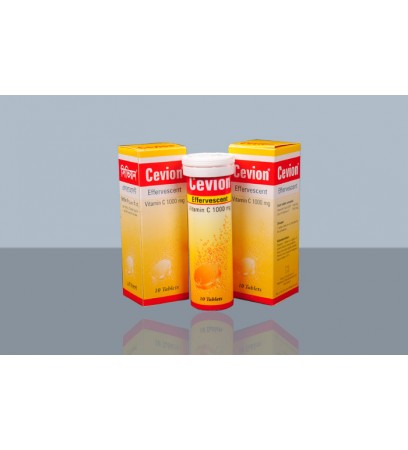Cevion 1000 Tablet
- Brand:Healthcare Pharmaceuticals Ltd
- Product Code: Vitamin C 1000mg
- Availability: In Stock
-
76.78Tk.
Generic
Vitamin C [Ascorbic acid]
Indications
Scurvy is a disease that can be prevented and treated with vitamin C. It may be used in the following situations: pregnancy, breastfeeding, infection, trauma, burns, cold exposure, post-surgery, fever, stress, peptic ulcer, cancer, methaemoglobinaemia, and newborns fed unfortified formulas. Haematuria, dental caries, pyorrhea, acne, infertility, atherosclerosis, fractures, leg ulcers, hay fever, vascular thrombosis prophylaxis, levodopa toxicity, succinyl-choline toxicity, and arsenic toxicity are among the conditions for which it is given. Long-term vitamin C intake is necessary to lower the risk of stroke in the elderly.
Pharmacology
The water-soluble vitamin vitamin C is easily absorbed from the gastrointestinal tract and is broadly disseminated throughout the body. It's thought to be involved in cellular respiration's biological oxidations and reductions. It's required for collagen and intracellular material formation. When dietary intake is insufficient and rising demand is not met, vitamin C insufficiency develops. Scurvy, a well-defined illness marked by capillary fragility, bleeding (particularly from small blood vessels and the gums), anemia, cartilage and bone abnormalities, and poor wound healing, is caused by deficiency.
Dosage & Administration
Oral administration-
- For the prevention of scurvy: 1 tablet daily
- For the treatment of scurvy: 1-2 tablets daily; but dose may be increased depending on the severity of the condition.
- For the reduction of risk of stroke in the elderly: 1-2 tablets daily.
- In other cases: 1 tablet daily or as directed by the physician.
- Maximum safe dose is 2000 mg daily in divided doses.
Parenteral administration-
- Vitamin C is usually administered orally. When oral administration is not feasible or when malabsorption is suspected, the drug may be administered IM, IV, or subcutaneously. When given parenterally, utilization of the vitamin reportedly is best after IM administration and that is the preferred parenteral route.
- For intravenous injection, dilution into a large volume parenteral such as Normal Saline, Water for Injection, or Glucose is recommended to minimize the adverse reactions associated with intravenous injection.
- The average protective dose of vitamin C for adults is 70 to 150 mg daily. In the presence of scurvy, doses of 300 mg to 1 g daily are recommended. However, as much as 6 g has been administered parenterally to normal adults without evidence of toxicity.
- To enhance wound healing, doses of 300 to 500 mg daily for a week or ten days both preoperatively and postoperatively are generally considered adequate, although considerably larger amounts have been recommended. In the treatment of burns, doses are governed by the extent of tissue injury. For severe burns, daily doses of 1 to 2 g are recommended. In other conditions in which the need for vitamin C is increased, three to five times the daily optimum allowances appear to be adequate.
- Parenteral drug products should be inspected visually for particulate matter and discoloration prior to administration, whenever the solution and container permit.
Interactions
Aminophylline, bleomycin, erythromycin, lactobionate, nafcillin, nitrofurantoin sodium, conjugated oestrogen, sodium bicarbonate, sulphafurazole diethanolamine, chloramphenicol sodium succinate, chlorthiazide sodium, and hydrocortisone sodium succinate are incompatible in solution with ascorbic acid.
Ascorbic acid improves iron absorption from the gastrointestinal system and increases the apparent half-life of paracetamol.
Contraindications
In blood illnesses such as thalassemia, G6PD deficiency, sickle cell disease, and hemochromatosis, vitamin C supplementation is not recommended. Supplements should not be taken immediately before or after angioplasty. Vitamin C supplements should be used with caution by diabetics because it elevates blood sugar levels.
In oxalate nephropathy or nephrolithiasis, vitamin C should be administered with caution since ascorbic acid enhances the possibilities of cysteine, urate, and oxalate stones forming.
Side Effects
Only mega-doses of vitamin C can cause diarrhoea, abdominal bloating, and iron overabsorption, which can be harmful in patients with thalassemia, sideroblastic anemia, and haemochromatosis; and hyperoxaluria, hyperuricosuria, and hemolysis in patients with glucose-6 phosphate dehydrogenase deficiency. A pregnant lady who consumes more over 5 gm per day may experience fetal abortion.
Pregnancy
The drug is safe in normal doses in pregnant women, but a daily intake of 5 gm or more is reported to have caused abortion. The drug may be taken safely during lactation.
Precautions
Neonatal scurvy has been linked to megadoses of vitamin C (greater than 1000 mg daily) consumed during pregnancy. Patients with hyperoxaluria should avoid taking megadoses of vitamin C. Because vitamin C is a reactive chemical in the redox system, it can cause false positive results in tests for glucose, uric acid, creatine, and occult blood.
Therapeutic Class
Vitamin-C Preparations
Storage Conditions
Should be stored in a dry place below 30˚C.
Pharmaceutical Name
Healthcare Pharmaceuticals Ltd.
Tags: Cevion 1000 Tablet

